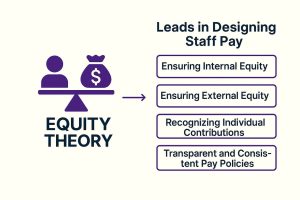Designing Staff Pay Structure with Equity
Equity Theory, developed by psychologist J. Stacy Adams, is widely used in designing fair and effective staff pay structures. It focuses on how employees perceive fairness in the workplace, particularly regarding compensati on and effort.
on and effort.
What is Equity Theory? Equity Theory states that:
- Employees compare their inputs (e.g., effort, skills, experience, education) and outcomes (e.g., salary, benefits, recognition) with those of others in similar roles.
- If they perceive inequity, for example, if they feel they are putting in more effort (inputs) but getting less reward (outcomes) they may become demotivated, disengaged, or leave the job.
How Equity Theory Influences Staff Pay Design
1. Ensuring Internal Equity
- Meaning: Fairness in pay among employees within the same organization.
- Action: Pay should reflect differences in job responsibilities, experience, or performance, but be consistent for similar roles.
- Example: Two Customer Service Agents with similar experience and performance should not have significantly different pay.
2. Ensuring External Equity
- Meaning: Pay competitiveness in comparison to similar jobs in the market.
- Action: Regular market benchmarking is essential to ensure employees feel fairly compensated compared to peers in other organizations.
- Example: If competitors offer 10% more for similar roles, staff may feel underpaid and leave.
3. Recognizing Individual Contributions
- Meaning: Pay must reflect individual performance and results.
- Action: Introduce merit-based pay, bonuses, or performance incentives to align outcomes with inputs.
- Example: High-performing employees should be rewarded more than average ones doing the same job.
4. Transparent and Consistent Pay Policies
- Meaning: Employees want clarity on how pay is determined.
- Action: Clearly communicate pay scales, criteria for raises, and bonus eligibility.
- Example: When staff understand how their pay is calculated, they are more likely to perceive it as fair.
5. Addressing Perceptions of Inequity Promptly
- Meaning: Even if pay is technically fair, perceived unfairness can be damaging.
- Action: Regular check-ins, surveys, or HR reviews can help detect and correct issues early.
Impact of Applying Equity Theory:
Positive outcomes:
- Increased job satisfaction
- Higher retention
- Better performance
- Improved morale
If ignored:
- Employee dissatisfaction
- High turnover
- Internal conflict or resentment
Equity Theory reminds employers that perceived fairness matters as much as actual fairness. By designing pay structures that are internally consistent, market-aligned, performance-based, and transparent, organizations can motivate employees and reduce turnover risk.



